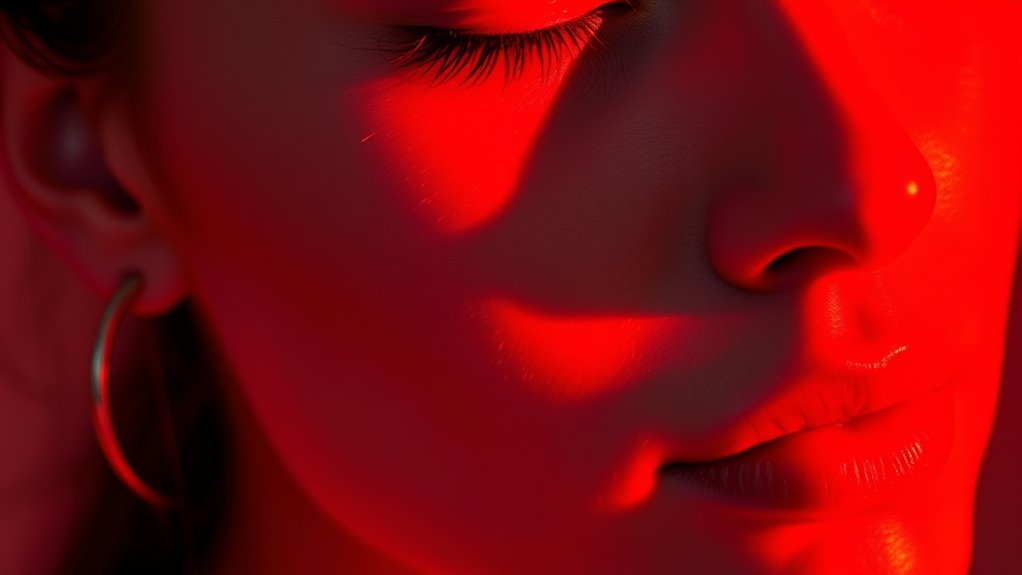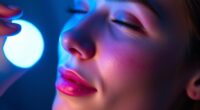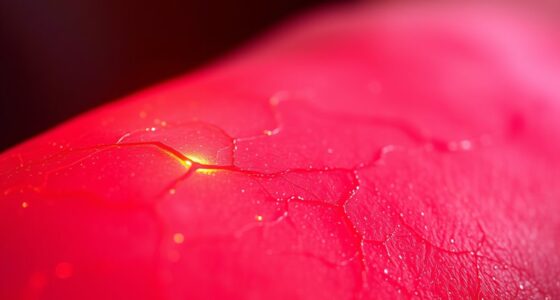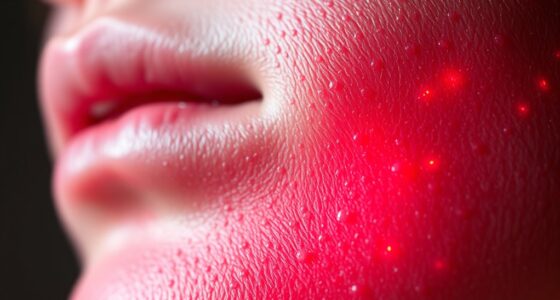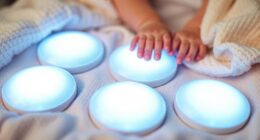For ideal results, use red light therapy on your skin 3 to 5 times weekly when starting. Pay attention to how your skin responds—if you notice redness or irritation, reduce the frequency or session time. As your skin adapts, you can adjust the routine or decrease sessions to maintain benefits. Stick with the basics, and you’ll discover more tips to maximize your skincare journey as you continue exploring.
Key Takeaways
- Start with 3-5 sessions weekly, adjusting based on skin response and tolerance.
- Use for about 10-20 minutes per session, gradually increasing as tolerated.
- Monitor skin reactions; reduce frequency if irritation or redness occurs.
- Follow manufacturer guidelines for your specific device to ensure safe use.
- Long-term benefits typically require consistent use over several weeks or months.
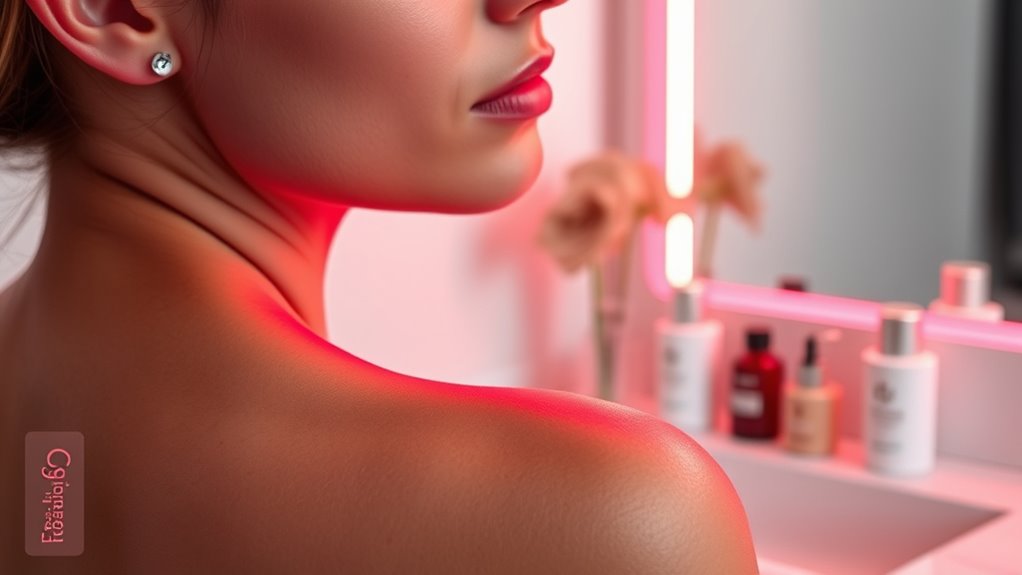
Red light therapy has gained popularity for its potential skin benefits, but figuring out how often to use it can be confusing. You might wonder if daily sessions are necessary or if using it a few times a week will do the trick. The truth is, the ideal frequency depends on your skin goals, the device you’re using, and your skin’s response. Generally, most people start with sessions three to five times weekly and adjust based on how their skin reacts. This schedule allows your skin to benefit from the therapy without overdoing it, which could lead to irritation or diminishing returns.
Most people start with 3-5 sessions weekly and adjust based on skin response.
If you’re targeting specific skin concerns like acne, fine lines, or inflammation, consistency is key. Many users find that sticking with a routine of three to five sessions per week for several weeks provides noticeable improvements. After that initial period, you might reduce frequency to maintain results, such as twice a week or once a week, depending on your skin’s response. Regular use over time can help stimulate collagen production, improve circulation, and reduce inflammation, but patience is essential; results often take several weeks to become visible.
You should also consider your skin’s sensitivity. If you’re new to red light therapy, start with shorter sessions—around 10 minutes—and observe how your skin reacts. If you notice any redness, dryness, or irritation, reduce the frequency or session length. Conversely, if your skin responds well, you can gradually increase the duration or frequency. Always listen to your skin; overuse can sometimes lead to adverse effects, such as dryness or irritation, especially if you have sensitive skin.
Another factor to keep in mind is the device’s specifications. Different devices emit varying wavelengths and intensities, which can influence how often you should use them. Follow the manufacturer’s instructions closely, as they typically provide recommended usage guidelines based on the device’s power output. If unsure, consulting with a dermatologist can help tailor a routine suited to your skin type and goals.
Additionally, understanding how light technology interacts with skin can help optimize your routine and prevent potential adverse effects. Ultimately, consistency and observing your skin’s response are your best guides. While some people see benefits after just a few weeks, others may need to continue therapy for months to achieve desired results. Red light therapy isn’t a quick fix, but with regular use and proper care, it can become a helpful part of your skincare routine. Just remember to start slow, monitor your skin’s reactions, and adjust frequency as needed to ensure safe and effective results.
Frequently Asked Questions
Can Red Light Therapy Replace Skincare Products?
Red light therapy can supplement your skincare routine but shouldn’t replace skincare products. It targets specific skin concerns like inflammation, wrinkles, and acne, enhancing your skin’s health. However, products like cleansers, moisturizers, and sunscreens provide essential nutrients and protection that red light therapy doesn’t offer. Combining both treatments gives you a thorough approach, maximizing benefits and supporting your skin’s overall health effectively.
Is Red Light Therapy Safe for Sensitive Skin?
Think of red light therapy like a gentle sunrise for your skin—it’s generally safe for sensitive skin. You might notice mild redness or warmth at first, but these effects typically fade quickly. According to studies, when used properly, red light therapy minimizes risks and boosts skin health. Always start with shorter sessions, monitor your skin’s response, and consult a dermatologist if you experience persistent irritation.
How Long Does It Take to See Results?
You can typically see results from red light therapy within 4 to 6 weeks of consistent use. You’ll notice improvements in skin tone, texture, and reduced inflammation as your body responds to the treatment. Keep in mind, individual results vary based on skin type and condition. To maximize benefits, follow your provider’s recommended schedule and use the therapy regularly, usually a few times a week.
Can Red Light Therapy Cause Skin Damage?
Red light therapy is generally safe, and skin damage is unlikely when used properly. Think of it like sunlight: moderate exposure offers benefits, but excessive use can cause irritation or burns. You won’t typically experience damage if you follow recommended guidelines and avoid overuse. Always start with shorter sessions, and consult a professional if you notice any adverse effects, ensuring your skin benefits without harm.
What Is the Ideal Time of Day to Use Red Light?
You should use red light therapy in the morning or early afternoon for best results. This timing helps boost your energy, improve circulation, and support skin repair during the day. Avoid late-night sessions, as they might interfere with your sleep cycle. Keep your sessions consistent, typically 10 to 20 minutes, depending on your device’s instructions. By sticking to this schedule, you’ll optimize benefits without disrupting your daily routine.
Conclusion
So, how often should you use red light therapy on your skin? Generally, 3 to 5 times a week is effective, but it depends on your skin’s needs and the device you’re using. Consistency is key to seeing results, yet overdoing it might cause irritation. Are you willing to commit to a routine that could transform your skin? Remember, listening to your body and adjusting accordingly will give you the best results.
